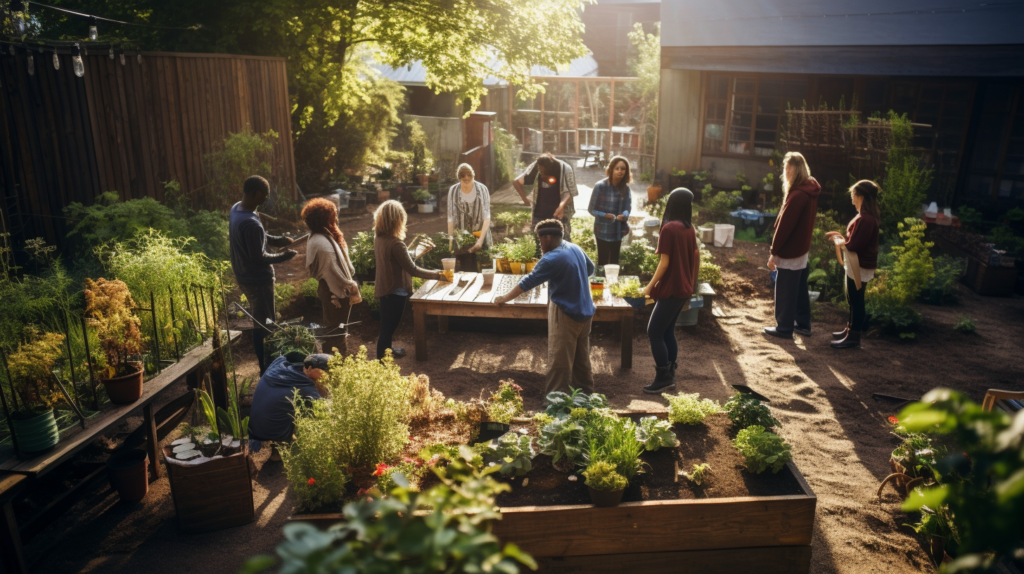Welcome to this informative article on empowering local communities through sustainable social change. In today’s world, it is crucial to recognize the importance of supporting and uplifting our local communities. By investing in sustainable initiatives that create positive social change, we can contribute to the growth, well-being, and empowerment of these communities.
Local communities play a vital role in shaping the fabric of society. They are the heart and soul of towns, cities, and neighborhoods, comprising diverse groups of people with unique identities, cultures, and aspirations. However, many local communities face various challenges that hinder their progress and development. It is essential to understand these challenges and work towards finding sustainable solutions that will uplift and transform these communities for the better.
In this article, we will explore the significance of local communities, their role in society, and the challenges they face. We will also delve into the concept of sustainable social change and discuss successful community-led initiatives that have made a positive impact. Additionally, we will explore the importance of inclusivity and participation in driving sustainable change.

Furthermore, we will delve into the establishment of collaborative partnerships with local stakeholders, governments, non-profit organizations, and businesses. These partnerships are crucial in implementing effective strategies and solutions that address the needs and aspirations of local communities.
We will also explore ways to address community challenges by identifying key issues, implementing innovative solutions, and measuring impact to track progress effectively. Promoting education and empowerment, ensuring environmental sustainability, and fostering cultural preservation and heritage are also critical components of empowering local communities.
Lastly, we will discuss the importance of measuring impact and ensuring long-term success to sustain the positive changes brought about by our efforts. Through continuous monitoring and evaluation, we can adapt strategies and approaches to maximize our social impact.
Together, let us embark on this journey to empower local communities through sustainable social change. By working collaboratively and addressing the unique needs of each community, we can create a brighter future for all.
Understanding the Importance of Local Communities
Local communities play a crucial role in society, acting as the backbone of social cohesion and collective progress. They are the vibrant hubs where people come together, live, work, and interact. Understanding the importance of local communities is key to empowering them through sustainable social change. Let’s dive deeper into this topic.
Defining Local Communities
Local communities can be defined as groups of people who live in close proximity to one another and share common characteristics, such as geographical location, cultural background, or shared interests. These communities can range from small neighborhoods to larger towns and cities. They are the building blocks of society, fostering a sense of belonging and connection among individuals.
The Role of Local Communities in Society
Local communities serve as the foundation for positive social change. They provide individuals with a sense of identity, support, and collaboration. Here are a few ways local communities contribute to society:
- Social Support: Local communities offer a support network and a sense of belonging, which can greatly enhance individuals’ well-being.
- Economic Growth: Thriving local communities drive economic growth by promoting entrepreneurship, creating job opportunities, and supporting local businesses.
- Cultural Preservation: Local communities are the keepers of cultural heritage, traditions, and indigenous knowledge, contributing to the rich tapestry of society.
- Democracy and Civic Engagement: Local communities are the breeding ground for civic action, political participation, and grassroots movements.
Challenges Faced by Local Communities
While local communities are essential to societal well-being, they also face various challenges that hinder their growth and development. It’s important to acknowledge and address these challenges to empower communities effectively. Some common challenges faced by local communities include:
- Social Inequality: Disparities in wealth, education, and access to resources can marginalize certain groups within a community.
- Limited Resources: Lack of funding, infrastructure, and resources can hinder local initiatives and limit community development.
- Social Isolation: In some cases, local communities may face isolation due to geographical location or cultural barriers, resulting in limited opportunities for growth.
- Environmental Issues: Communities often grapple with environmental challenges, such as pollution, deforestation, and climate change, which can have a severe impact on their well-being.
To overcome these challenges, a comprehensive approach is needed to support and empower local communities through sustainable social change. In the following sections, we will delve into the strategies and initiatives that can help achieve this goal.
Identifying Sustainable Social Change Initiatives
When it comes to creating sustainable social change, it’s important to identify initiatives that have a lasting impact on local communities. These initiatives should not only address immediate needs but also create long-term solutions that promote positive change. In this section, we will explore what sustainable social change means, provide examples of successful community-led initiatives, and highlight the importance of inclusivity and participation in the process.
Defining Sustainable Social Change
Sustainable social change refers to actions and initiatives that result in long-term benefits for individuals, communities, and society as a whole. These initiatives are designed to address social, economic, and environmental challenges in a way that takes into account the needs of both present and future generations. Sustainable social change focuses on creating lasting change by addressing the root causes of societal problems rather than just treating the symptoms.
Examples of Successful Community-led Initiatives
Community-led initiatives play a crucial role in driving sustainable social change. By harnessing the power and knowledge of local communities, these initiatives are able to address specific challenges in a way that is tailored to the needs of the people they serve. Here are a few examples of successful community-led initiatives:
- Community Gardens – These initiatives promote sustainable agriculture and provide a source of fresh, healthy food for local residents. They not only address food security but also encourage community engagement and education about sustainable farming practices.
- Microfinance Programs – By providing small loans to individuals who lack access to traditional banking services, microfinance programs empower local entrepreneurs to start or expand their businesses. This leads to economic growth and poverty reduction within the community.
- Community Health Clinics – These clinics focus on providing accessible and affordable healthcare to underserved communities. They not only address immediate healthcare needs but also educate community members about preventive measures and healthy lifestyle choices.
The Importance of Inclusivity and Participation
Inclusivity and participation are key elements in identifying sustainable social change initiatives. By involving all relevant stakeholders, including community members, local organizations, and government agencies, in the decision-making process, initiatives can better understand the unique needs and challenges of the community. This ensures that the solutions implemented are truly sustainable and effective.

Inclusivity and participation also foster a sense of ownership and empowerment within the community. When individuals have a say in the initiatives that affect them, they are more likely to actively participate and contribute to their success. This collaboration creates a sense of community and strengthens social bonds, leading to a more resilient and thriving society.
By identifying sustainable social change initiatives that prioritize inclusivity, participation, and long-term impact, we can empower local communities to create positive change that lasts. These initiatives not only address immediate challenges but also pave the way for a brighter and more sustainable future for all. So, let’s come together and work towards a world where everyone has an equal opportunity to thrive.
Establishing Collaborative Partnerships
Building effective and collaborative partnerships is crucial when it comes to empowering local communities through sustainable social change initiatives. No single organization or entity can tackle all the challenges faced by a community alone. By working together with local stakeholders, governments, non-profit organizations, businesses, and entrepreneurs, we can create a collective impact that leads to long-lasting change.
Building Relationships with Local Stakeholders
- Why is it important?
Building relationships with local stakeholders such as community leaders, residents, and organizations is essential for understanding the specific needs and aspirations of the community. Their insights, experiences, and knowledge can help shape initiatives that are truly responsive and relevant. - How to do it effectively?
- Engage in open and honest communication: Listen attentively to the concerns, ideas, and suggestions of local stakeholders. Create spaces for dialogue and collaboration, where everyone feels heard and valued.
- Foster trust: Building trust takes time and consistency. Be transparent, reliable, and uphold your commitments. Show genuine care and respect for the community’s perspectives and aspirations.
- Be inclusive: Ensure that all voices within the community are represented and included in decision-making processes. Pay attention to marginalized groups and ensure equal opportunities for participation.
- Quote: “Working in collaboration with local stakeholders provides valuable insights into the unique strengths, challenges, and aspirations of the community. It enables us to develop solutions that are tailored to their specific needs.”
Working with Local Government and Non-profit Organizations
- Why is it important?
Local governments and non-profit organizations play a vital role in implementing sustainable social change initiatives. They have the resources, expertise, and experience necessary to navigate bureaucratic processes and address systemic issues. - How to establish partnerships?
- Identify common goals: Find alignment between your organization’s objectives and the local government or non-profit organization’s mission. Identify areas where collaboration can lead to greater impact and mutually beneficial outcomes.
- Seek shared value: Understand the resources, expertise, and networks that each partner brings to the table. Identify how each partner can leverage their strengths to contribute to the collaboration.
- Develop a Memorandum of Understanding (MOU): A written agreement that outlines the roles, responsibilities, and expectations of each partner ensures clarity and accountability.
- Quote: “Collaborating with local governments and non-profit organizations allows us to pool resources, share knowledge, and combine efforts to achieve sustainable social change at a larger scale.”

Engaging Businesses and Entrepreneurs
- Why is it important?
Businesses and entrepreneurs have the power to drive economic growth and create employment opportunities within a community. By engaging them in sustainable social change initiatives, we can leverage their resources, innovative ideas, and networks to address social and environmental challenges. - How to engage businesses and entrepreneurs effectively?
- Emphasize the business case for sustainability: Showcase how sustainable social change initiatives can lead to positive brand reputation, increased customer loyalty, and long-term profitability.
- Foster a win-win partnership: Identify ways in which businesses and entrepreneurs can actively contribute to the community’s development while achieving their own business objectives. Emphasize the mutual benefits of collaboration.
- Recognize and showcase success stories: Highlight the businesses and entrepreneurs that are making a positive impact within the community. Celebrate their efforts, share their stories, and inspire others to follow suit.
- Quote: “When businesses and entrepreneurs align their interests with the community’s needs, they can become powerful agents of change. By engaging them in sustainable initiatives, we can create a thriving ecosystem that benefits everyone.”
Establishing collaborative partnerships is not only about sharing resources and expertise but also about fostering a sense of collective responsibility and ownership of the community’s development. By working together, we can amplify our impact and create sustainable social change that empowers and uplifts local communities for generations to come.
Developing Solutions for Community Challenges
Local communities face various challenges that require innovative solutions to create lasting change. By identifying key issues, implementing innovative solutions, and measuring impact, we can address these challenges effectively and empower local communities to thrive. Here are some key strategies for developing solutions for community challenges:
Identifying Key Issues within the Community
To develop effective solutions, it is essential to understand the unique challenges faced by the local community. This can be done through research, community consultations, and needs assessments. By identifying the most pressing issues, we can prioritize our efforts towards addressing them.
Implementing Innovative Solutions
Once the key issues are identified, it’s important to think creatively and implement innovative solutions. These solutions should be tailored to the specific needs and resources of the community. It’s crucial to involve community members in the development and implementation process to ensure that the solutions are sustainable and effective.
Measuring Impact and Tracking Progress
To ensure the effectiveness of our solutions, it’s essential to measure their impact and track progress over time. This can be done through various monitoring and evaluation methods, such as surveys, interviews, and data analysis. By regularly assessing our efforts, we can make adjustments as necessary and ensure that our solutions are making a positive and lasting impact.
“Innovation is about solving problems in creative and effective ways. By applying innovative thinking to community challenges, we can create sustainable solutions that address the root causes of these issues.”
By developing solutions for community challenges, we can empower local communities to overcome obstacles and create a better future. This approach not only addresses the immediate needs of the community but also enables them to build resilience and self-reliance. Together, with collaborative partnerships and a focus on education and empowerment, we can create sustainable social change that benefits everyone.
Promoting Education and Empowerment
Education is the key to empowerment and social change. When communities have access to quality education, it opens doors to new opportunities and allows individuals to reach their full potential. In this section, we will explore how promoting education can empower local communities.
Access to Quality Education for All
Education is not a privilege reserved for a few; it is a fundamental right that should be accessible to all members of a community. By promoting access to quality education for all, we can:
- Expand opportunities: Education equips individuals with knowledge and skills that can help them secure better employment opportunities, improve their income levels, and escape the cycle of poverty.
- Promote social mobility: With education, individuals can break barriers and overcome social inequalities. It provides a pathway for people to achieve upward social mobility and improve their living conditions.
- Foster critical thinking: Education nurtures critical thinking skills, encouraging individuals to question, analyze, and solve problems. This empowers them to actively participate in decision-making processes and contribute to the development of their communities.
Skill-building Programs and Vocational Training
In addition to formal education, skill-building programs and vocational training play a vital role in empowering local communities. These initiatives:
- Address specific needs: Skill-building programs and vocational training can be tailored to address the specific needs of a community. For example, in rural areas, agricultural training can improve farming techniques and increase agricultural productivity.
- Enhance employability: By equipping individuals with practical skills, vocational training enhances their employability. This not only helps individuals secure jobs but also contributes to the economic growth of the community.
- Encourage entrepreneurship: Skill-building programs can also foster entrepreneurship within communities. By providing training in areas such as business management and marketing, individuals are empowered to start their own businesses, creating job opportunities for themselves and others.
Promoting Gender Equality and Women’s Empowerment
A key aspect of promoting education in local communities is ensuring gender equality and women’s empowerment. This involves:
- Breaking gender stereotypes: Education plays a crucial role in challenging gender stereotypes and promoting equality. By providing both girls and boys with equal access to education, we can break down barriers and create a more inclusive society.
- Empowering women: Education empowers women by giving them the knowledge and skills they need to make informed decisions, advocate for their rights, and contribute to economic and social development.
- Reducing poverty and improving health outcomes: Studies have shown that when women receive an education, poverty rates decrease, and health outcomes improve not only for them but also for their families and communities.
“Education is the most powerful weapon which you can use to change the world.” – Nelson Mandela
By promoting education and empowerment in local communities, we can create a ripple effect of positive social change. Education opens doors, builds bridges, and empowers individuals to shape their own destinies. It is an investment in the future of the community and a catalyst for sustainable development.
Ensuring Environmental Sustainability
The concept of environmental sustainability is becoming increasingly important as our planet faces various environmental challenges. It is crucial for local communities to play a role in preserving and protecting the environment for future generations. Here are some ways in which local communities can ensure environmental sustainability:
Encouraging Sustainable Practices
One of the first steps towards environmental sustainability is to encourage and promote sustainable practices within the community.
- Reducing Waste: Encouraging community members to reduce, reuse, and recycle can go a long way in minimizing waste. This can be done through awareness campaigns, educational programs, and the creation of recycling facilities within the community.
- Energy Conservation: Promoting energy-efficient practices such as switching to LED lights, using energy-saving appliances, and reducing unnecessary energy consumption can significantly reduce the community’s carbon footprint.
- Water Conservation: Educating community members about the importance of water conservation and implementing water-saving measures, such as installing rainwater harvesting systems and promoting water-efficient irrigation practices, can help preserve this precious resource.

Promoting Conservation and Biodiversity
Preserving biodiversity is crucial for maintaining a healthy and thriving ecosystem. Here are some ways local communities can contribute to conservation efforts:
- Protecting Natural Habitats: Identifying and preserving natural habitats within the community can help protect vulnerable species and maintain biodiversity. This can be done through the establishment of protected areas, nature reserves, and wildlife corridors.
- Planting Native Species: Encouraging the planting of native vegetation helps maintain the balance of local ecosystems and supports local wildlife populations. It also reduces the need for excessive water and fertilizer use.
- Awareness and Education: Raising awareness about the importance of biodiversity and the role it plays in maintaining ecosystem health can help foster a sense of stewardship among community members. Educational programs, nature walks, and workshops can all contribute to this effort.
Addressing Climate Change
Climate change is one of the greatest challenges facing our planet today. Local communities can take steps to mitigate and adapt to climate change:
- Reducing Carbon Emissions: Reducing greenhouse gas emissions is crucial in the fight against climate change. Communities can promote the use of clean and renewable energy sources, encourage energy-efficient transportation options such as walking, cycling, and carpooling, and support initiatives to reduce carbon emissions.
- Resilience and Adaptation: Building resilience to climate change impacts is essential for communities to withstand and recover from the effects of extreme weather events. This can involve measures such as improving infrastructure, implementing early warning systems, and developing emergency response plans.
- Promoting Sustainable Agriculture: Encouraging sustainable farming practices, such as organic farming and agroforestry, can help reduce the environmental impact of agriculture and increase the resilience of local food systems in the face of climate change.
By prioritizing environmental sustainability, local communities can contribute to the global effort in preserving our planet for future generations. Every small action collectively adds up to make a significant impact. Let us all work together to create a sustainable and thriving environment for ourselves and future generations.
Fostering Cultural Preservation and Heritage
Preserving and promoting cultural preservation and heritage is a vital component of empowering local communities through sustainable social change. Cultural preservation ensures that the unique traditions, knowledge, and customs of a community are passed down from generation to generation. It helps to maintain a sense of identity and pride among community members and creates opportunities for cultural exchange and understanding. Here are some key ways in which fostering cultural preservation and heritage can make a positive impact:
Preserving Indigenous Knowledge and Traditions
Indigenous communities across the world possess deep-rooted knowledge and traditions that are often at risk of being lost over time. Fostering cultural preservation involves recognizing the value of this indigenous knowledge and taking steps to preserve it. This can be done through initiatives such as:
- Documenting oral histories and traditional practices
- Supporting the passing down of traditional skills and craftsmanship
- Establishing cultural centers or museums to showcase indigenous art, artifacts, and history
Supporting Local Arts and Cultural Festivals
Arts and cultural festivals play a crucial role in celebrating and showcasing the rich heritage of a community. These events provide a platform for local artists, musicians, and performers to share their talents with a wider audience. By supporting and participating in these festivals, local communities can:
- Boost tourism and economic development
- Enhance community cohesion and pride
- Encourage the transmission of cultural values to younger generations
Promoting Cultural Exchange and Understanding
Cultural preservation is not just about preserving one’s own heritage but also about fostering an appreciation for the diversity of cultures around the world. By promoting cultural exchange and understanding, local communities can:
- Organize cultural exchange programs with neighboring communities or international partners
- Encourage cultural diversity in public spaces, such as through public art installations or cultural events
- Educate community members about different cultural practices and traditions
“Preserving cultural heritage is an investment in the future. Communities that value and embrace their cultural identity are more likely to thrive and have a strong sense of cohesion.”
By fostering cultural preservation and heritage, local communities can strengthen their social fabric, enhance tourism and economic opportunities, and create a sense of pride and belonging among community members. It is a vital pillar in sustainable social change initiatives that seek to empower and uplift local communities.
Measuring Impact and Ensuring Long-term Success
When it comes to implementing sustainable social change initiatives in local communities, it is essential to measure the impact and track progress to ensure long-term success. This allows organizations and communities to understand the effectiveness of their efforts and make necessary adjustments to improve outcomes. Here are some key considerations for measuring impact and ensuring long-term success:
Metrics for Assessing Social Impact
- Identify measurable indicators: Determine the specific outcomes and goals of your initiative and identify metrics that can effectively measure progress towards those goals. For example, if your initiative aims to improve access to education, metrics could include the number of children enrolled in schools, literacy rates, and dropout rates.
- Use both quantitative and qualitative data: While quantitative data provides valuable numerical insights, such as the number of beneficiaries reached, qualitative data provides a deeper understanding of the impact by capturing personal stories and experiences. Utilize a combination of both to get a holistic view of the initiative’s impact.
- Engage stakeholders: Involve key stakeholders, such as community members, local leaders, and partner organizations, in the measurement process. Their perspectives and feedback can provide valuable insights and ensure that the assessment captures the true impact of the initiative.
- Establish baseline data: Before implementing any changes, collect baseline data to establish a starting point. This will allow you to compare the impact after implementing your initiative and measure the extent of the change.

Continuous Monitoring and Evaluation
- Regularly collect data: Implement a monitoring and evaluation system that allows for the regular collection of data throughout the initiative’s lifespan. This ensures that you can track progress and make timely adjustments as needed.
- Identify key milestones: Set specific milestones and benchmarks to assess progress. This helps to break down the impact assessment into manageable stages and provides an opportunity to celebrate achievements along the way.
- Gather feedback: Regularly seek feedback from the community and other stakeholders to gauge their perception of the initiative’s impact. This feedback can provide valuable insights and identify areas for improvement.
- Adapt and iterate: Use the data collected through monitoring and evaluation to adapt your strategies and tactics as needed. It’s important to be flexible and willing to make changes based on the feedback and evidence gathered.
Adapting Strategies for Long-term Success
- Take a long-term perspective: Sustainable change requires a long-term perspective. Plan for the initiative’s future beyond the initial implementation phase, and identify strategies to ensure its continuation and success.
- Build local capacity: Empower local community members through training and capacity-building programs. This helps to ensure that the skills and knowledge required to sustain the initiative are transferred to the community.
- Leverage partnerships: Collaborate with local stakeholders and organizations to leverage their expertise, resources, and networks. This can help to build a strong support system and increase the chances of long-term success.
- Advocate for policy changes: Identify opportunities to advocate for policy changes that support the sustainability of your initiative. Engage with local government officials and policymakers to create an enabling environment that facilitates long-term impact.
Measuring impact and ensuring long-term success is an ongoing process. It requires a commitment to monitoring, evaluation, and adaptation to ensure that sustainable change is achieved and maintained. By employing these strategies, organizations and communities can enhance their understanding of the impact they are making and create lasting positive change.
Conclusion
In conclusion, empowering local communities through sustainable social change is crucial for creating a more equitable and inclusive society. By understanding the importance of local communities and the challenges they face, we can identify sustainable initiatives that truly make a difference.
Establishing collaborative partnerships with local stakeholders, governments, non-profit organizations, and businesses is key in implementing effective solutions for community challenges. By working together, we can leverage resources, expertise, and networks to drive positive change.
Promoting education and empowerment, ensuring environmental sustainability, and fostering cultural preservation and heritage are essential pillars in empowering local communities. These efforts not only uplift individuals and communities but also contribute to the overall wellbeing of society.
Measuring impact and tracking progress is vital to ensure that our initiatives are making a real difference. By using metrics for assessing social impact, continuously monitoring and evaluating our projects, and adapting strategies for long-term success, we can ensure the sustainability of our efforts.
Empowering local communities is not a one-time task but an ongoing commitment. It requires dedication, collaboration, and a deep understanding of the needs and aspirations of the community. Together, we can create lasting change and build a better future for all. Let’s uplift and empower our local communities to create a world that is fair, equitable, and sustainable.
Frequently Asked Questions
- What is sustainable social change?Sustainable social change refers to long-lasting and positive transformations in communities that address social, economic, and environmental issues in a way that ensures the well-being and prosperity of both current and future generations.
- How can local communities be empowered through sustainable social change?Local communities can be empowered through sustainable social change by promoting inclusivity, equity, and participation in decision-making processes. This can be achieved through education, capacity-building, access to resources, and the promotion of sustainable practices and policies.
- What are some examples of sustainable social change initiatives?Examples of sustainable social change initiatives include community-led renewable energy projects, sustainable agriculture and food systems, waste reduction and recycling programs, education and skill-building programs for marginalized groups, and initiatives promoting gender equality and social justice.
- Why is sustainable social change important for local communities?Sustainable social change is important for local communities because it fosters resilience, improves quality of life, and creates lasting positive impacts. It allows for the empowerment of marginalized groups, the preservation of natural resources, and the creation of more inclusive and equitable societies.
- How can individuals contribute to sustainable social change?Individuals can contribute to sustainable social change by supporting local initiatives and organizations, volunteering their time and skills, advocating for policies and practices that promote sustainability and social justice, and making conscious choices in their daily lives to reduce their ecological footprint.



